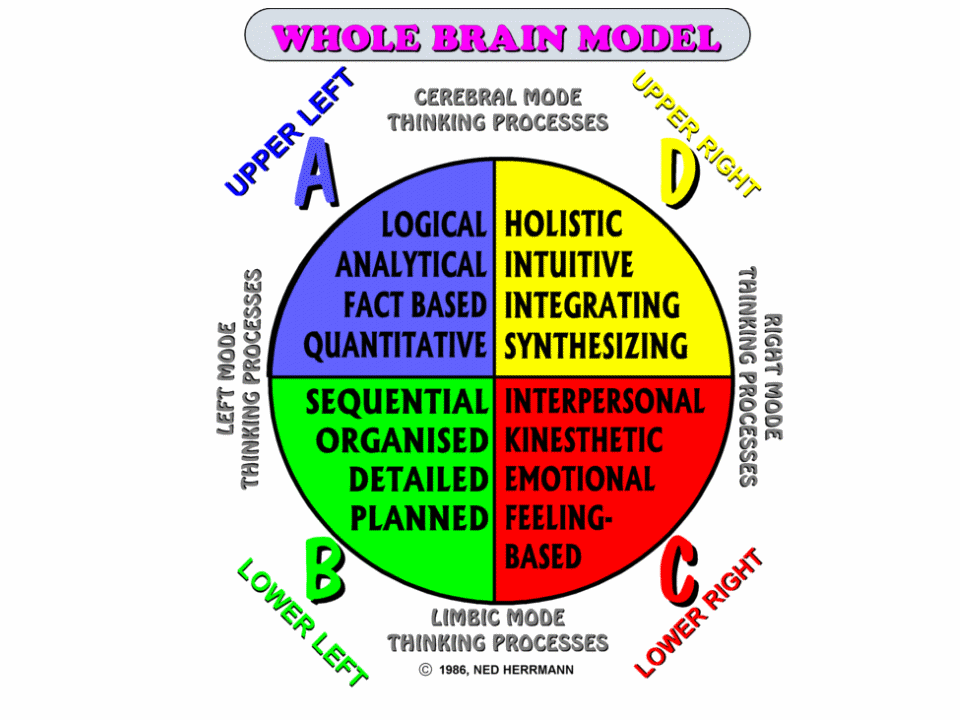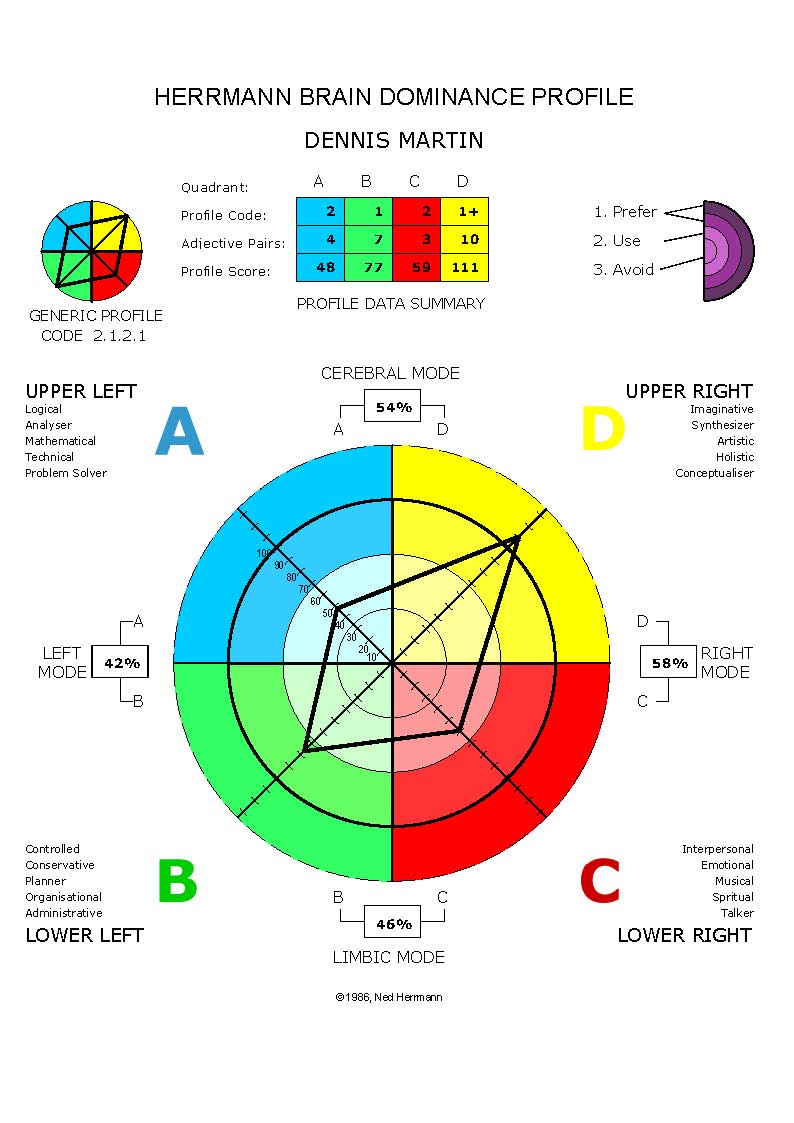to help themselves,
to release and realise more of their potential
Dennis Martin Consultants
Contact us and see how we can work together and create a path to the future that you, your people and your business deserve.
- home index page
- how we differ
- whole brain thinking
Whole Brain Thinking

Page Key Points
On this page we cover:
* the whole brain thinking model and HBDI (shown above)
* Dennis' HBDI thinking preferences profile
* how we use them in our learning and training experiences for mentors and mentees
* outline common practical uses of the whole brain model and HBDI
Whole Brain Thinking (what is it?)
Most people know that the human brain comprises a left brain hemisphere and a right brain hemisphere.
In addition, not as well known is that the brain has an older lower section called the Limbic System and a younger upper section (frontal lobes) called the Cerebral section.
Combining these four sections into the model above and learning how to use each section separately and in combinations with other sections and using all four quadrants simultaneously creates Whole Brain Thinking.
The whole brain model shown above was created by Ned Herrmann along with the Herrmann Brain Dominance Instrument (HBDI) which allows a profile of thinking preferences to be prepared.
In 1989-1990 I trained in North Carolina, USA with Ned Herrmann.
Click to view Dennis's background
In 1990 Ned asked me to create a Herrmann Institute in the North of the U.K. (Yorkshire).
I did so and it is still functioning successfully.
I have attached my thinking preferences profile below:

What Does the Whole Brain Thinking Preference Profile above Mean?
My profile contains a lot of valuable information about my thinking that will enable me to make empowering choices for my future and realising more of my potential.
In brief, the profile shows my thinking preferences across the four quadrants of the whole brain model that makes up whole brain thinking.
It has 3 sections: the inner section from the dot in the middle (score 0) to the smallest circle (score 33) on the HBDI survey form. Any score between 0-33 indicates an avoidance of this thinking style by the participant. There are no avoidances in my profile.
I have scored in the blue left and red right quadrants 48 and 59 which indicates that I can and will use these thinking preferences when I need to, but they are not my favourite or dominant thinking style.
For me, my dominant thinking preferences are in the green left and yellow right quadrants, scores of 77 and 111.
When the scores in each quadrant are connected it produces a 'kite-like' shape that is the overall profile of my thinking preferences.
In total, the whole brain model represents the two hemispheres left and right of the brain and the two main functions of cerebral thinking and limbic 'emotional thinking', creating four different thinking styles / preferences as described above and on the profile and model shown above.
My thinking preferences will change through time and with the effects of many different experiences such as education, occupation, parenthood etc.
Want to Know What YOUR Thinking Preferences Are?
If you would be interested in having your thinking preferences profiled (as per my example above), please contact me by completing the Contact Help Form below and click the 'Send to Dennis' button
Why Bother? What Are the Benefits of Whole Brain Thinking?
There are six major benefits to whole brain thinking:
1. Improved Problem-Solving:
being adaptable in your thought processes allows you to better tackle a wide variety of issues with a wider range of options
2. Enhanced Creativity:
engaging all parts of your brain, not just
your preferred sections, will enable you to break out of your habitual established
thought patterns and come up with more creative solutions and
ideas
3. Better Decision Making:
more perspectives gained from whole brain thinking can
lead to better decision-making as you consider more aspects of a
situation, and more options, before deciding on a course of action
4. Versatility:
whole brain thinking allows you to work more effectively in different
situations and with different types of people. People think in different ways, so being able to understand and apply different
thinking styles can help in interpersonal interactions and synergy
5. Personal Growth:
as you strengthen underused parts of your brain, you may find new skills and abilities emerging; improved curiosity and analytical logic and you may be able to release and realise more of your potential as a result
6. Improved Communications:
we all communicate from our preferred thinking quadrants (as shown on my profile above, for example). Knowing this and having been trained in the clues emerging from a person's language, you will be able to 'tune in' to different thinking styles and be able to 'mirror' them making communications more effective.
You may also benefit from the synergy that is often created by the interactions of the six benefits above.
How to Identify When Whole Brain Thinking is Needed?
There are no fixed 'rules' or a formula for this, it is more situational depending on the characteristics of the circumstances.
For example, if your usual thinking approaches have not yielded what you want in a situation where you are seeking creative solutions - in effect, 'you are stuck' - try shifting your thinking into those quadrants that you rarely use or avoid.
Or deliberately consider the situation 4 times, once from each quadrant (i.e. whole brain thinking)
Maybe the nature of the task indicates a particular thinking style would be needed. If analysing data to help determine a budget, left brain cerebral thinking may be the best match. Or, if planning a show of some sort, or a surprise party, switching to right brain limbic thinking will likely prove fruitful in creating positive emotions and fun
Sometimes it may just be a level of frustration at having to make several attempts at something when adopting a whole brain thinking approach or another quadrant would have achieved the desired results more quickly and easily. Some 'trial and error' may be needed if negative emotional reactions are emerging
Or, maybe you're not having 'trouble' getting results with your usual habitual style of thinking.....but, to your surprise, when you apply whole brain thinking to the same task you find unexpected benefits.
Try it and see.
How do We Use the Whole Brain Thinking Model and Thinking Preferences Profiles?
In our training and learning experiences for mentors, mentee(s) and leader(s) we use both the profiles and the whole brain thinking model.
All participants receive a copy of their individual thinking preferences profile as illustrated by mine above.
If they are involved in a team of mentors and / or mentee(s), they will also receive a team thinking profile based on the individual profiles of all team members.
WHY DO WE DO THIS?
Because we are all different, unique and one of the things that makes this so is how we think, mentally process our experiences, solve problems, create our mental databases etc.
In particular, how we learn is significantly influenced by how we think and we get valuable insights on this from our HBDI profiles.
For example, when we process the profiles for a mentor and a mentee(s) we are able to discuss with them the resulting profiles, their similarities and differences and how whole brain thinking may best be used to optimise their learning.
This enables us, with the participants, to match up mentors and mentee(s) based on their thinking preferences profiles and, in appropriate circumstances, we can deliberately mis-match profiles so that mentors and mentee(s) experience a more creative, stimulating and different learning process.
This is a good example of Bespoke Made-to-Measure Mentoring in practice.
All of this is fully covered in the mentor's and mentee's training programme and learning experiences.
How Does Whole Brain Thinking Influence Learning?
We also apply the whole brain model to our training sessions to optimise the learning process by matching and stretching the participants' thinking preferences re the training content and methods.
This means that they learn the training content more easily and thoroughly and they learn the transferrable skill of how to use their thinking preferences more effectively.
When a mentee(s) is facing problems or opportunities or uncertainties, the mentor and mentee(s) will now understand that they will be thinking about it from their existing thinking profiles and habitual preferences.
If they get 'stuck' though, they will now be able to use the whole brain model to focus on each quadrant's thinking preference in turn, let's say.
They will be able to examine the situation from the left brain quadrants of logical, analytical thinking and then examine the same situation from the right brain quadrants of emotional or conceptual thinking by taking a 'whole brain walkaround' the model.
The HBDI and the whole brain model are both very useful in helping the mentor to help the mentee(s) to boost the effectiveness of their internal thinking environment, creativity and learning processes as a key step in releasing and realising more of their potential.
What are the Most Common Uses of Whole Brain Thinking in Practice?
Practical uses of the HBDI and the whole brain model, in addition to learning as explained above, may include, for example:
*** Self Improvement, Growth and Personal Development
The thinking preferences profile (see above for a copy of mine) is very helpful in enabling mentors, mentees and leaders to gain an insight and understanding of how they process information, learn effectively, be creative etc. mentally and how this relates to others' thinking styles.
In particular, it helps mentors and mentees understand each other's approach, thinking habits including 'avoidances', how to value differences and make positive synergistic use of them.
It also gives them an 'objective' reference point when it comes to dealing with conflicts and communication difficulties by encouraging whole brain thinking using each of the quadrants of the model.
The whole brain model is also a great creativity and problem solving tool and can be used to get fresh and different views of any situation.
*** Teamworking
Both the HBDI and whole brain model enables an understanding of team strengths and weaknesses and facilitates constructive giving and receiving of feedback for learning purposes.
In addition, a team profile is available that shows the average thinking preferences profile for the team and a composite profile that overlays each team members profile to show the distribution of thinking differences in the team.
This is very useful in spotting if there are 'tribes' within the team and / or individuals who's thinking preferences are significantly different.
The team profile also shows a dominance map which clearly highlights members of the team who have a thinking profile indicating a high potential to be a natural teamwork facilitator.
The whole brain thinking model may also be used to create a profile of a situation or problem. This is called a proforma and enables mentors and mentees and leaders to compare their profiles against it and / or how they differ and by how much.
*** Communications
We all communicate from our thinking preferences profile, often with strong dominant quadrants and / or avoidances of other quadrants.
The HBDI profile enables analysis of how well differences in a team, or in an individual mentee's situation, are being turned to advantage or are disrupting communications.
It also highlights how well whole brain thinking is being put to use to help an individual mentee or a team release and realise more of their potential.
*** Creativity and innovation
The whole brain model is a valuable tool for creating new ideas and for viewing unrealised possibilities (i.e. potential) in a new way, which often also generates increased synergy in the team or by a mentee and mentor or with other colleagues.
It has many practical uses in this regard including generating ideas, possibilities, differences etc. by viewing the situation or concept from each quadrant's characteristics in turn and then from the 'whole brain'.
*** Giving and receiving feedback for learning purposes
Both the HBDI and the whole brain model facilitate preparation for the giving and receiving of feedback in face-to-face interactions in a positive mutual learning way.
If the giver and receiver of feedback for learning purposes both have a profile of their thinking preferences, they can clarify similarities and differences in thinking; use the model to 'map' what the situation is and requires (i.e. content); and use their profiles to agree on the best way of sharing the feedback (i.e. process) and on what happens next?
Please click any or all of the links below if you would like some more information
* The Lubrizol Story (of how we won a UK National Training Award for a 'revolutionary and inspiring' process based on complex adaptive systems and whole brain thinking in a manufacturing business)
* bespoke and different (how we differ)
You may also have comments, questions, suggestions etc. that you wish to share with me. Please contact me via the Contact Help Form for Dennis below and I'll get back to you
Go to our Home Page
Page Summary
On this Whole Brain Thinking page we have covered:
* the whole brain thinking model and HBDI
* Dennis' HBDI thinking preferences profile
* how we use them in our learning and training experiences for mentors and mentees
* outline common practical uses of the whole brain model and HBDI
We've covered a lot of ground on this page and I just want to THANK YOU for visiting my web site and reading this page. Your attention is much appreciated.
I hope you found the page as worthwhile and interesting reading it as I did writing it.
Kindest regards,
Dennis
